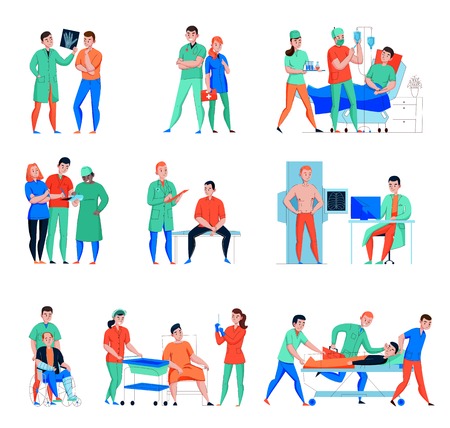Introduction to Community Rehabilitation in the UK
Community rehabilitation services play a vital role within the UKs health and social care framework, providing essential support for individuals recovering from injury, illness, or long-term conditions. These services are delivered outside of acute hospital settings, often in patients’ homes or local community centres, and focus on helping people regain independence, improve their quality of life, and reintegrate into society. The objectives of community rehabilitation include promoting physical recovery, enhancing mental wellbeing, and supporting social participation. In the context of the UKs diverse population and evolving healthcare demands, community rehabilitation has become increasingly significant as it bridges the gap between hospital care and independent living. By empowering service users to take control of their own recovery journeys, these services underpin not only personal resilience but also broader public health goals. Their importance is underscored by national strategies aiming to reduce hospital admissions, prevent unnecessary residential care placements, and ensure that all individuals—regardless of background—have access to tailored, person-centred support within their communities.
Funding Constraints and Resource Allocation
The sustainability of community rehabilitation services in the UK is deeply intertwined with the funding environment faced by both the NHS and local authorities. Over recent years, persistent funding constraints have placed immense pressure on these organisations, directly impacting the provision, reach, and quality of community rehab programmes. As someone who has worked on the frontlines, I have witnessed how budget limitations often mean difficult choices—whether its deciding which services to prioritise or having to reduce staff hours despite growing patient demand.
One of the core challenges is the way funding is allocated between acute and community settings. Traditionally, acute care tends to attract more immediate investment due to its urgent nature. Meanwhile, community rehab—though essential for long-term recovery and prevention of hospital readmissions—often finds itself lower down the pecking order when it comes to resource allocation. This imbalance not only affects service capacity but also undermines efforts towards integrated care.
To better understand these pressures, let’s look at a simplified comparison:
| Area | Acute Care | Community Rehab Services |
|---|---|---|
| Funding Priority | High | Moderate/Low |
| Staffing Levels | Relatively Stable | Often Variable/Understaffed |
| Investment in Equipment | Sufficient/Up-to-date | Lagging/Outdated |
This disparity means that community rehab teams are frequently forced to do more with less. Waiting lists grow longer, caseloads become unmanageable, and valuable preventative work may be sidelined. For patients, this translates into delayed interventions and potentially poorer outcomes—a reality that can be frustrating for both service users and practitioners alike.
The ongoing financial squeeze has also led local authorities to re-examine eligibility criteria for community rehab support. In practice, this can result in stricter thresholds for access, meaning some individuals with moderate needs might miss out on timely rehabilitation altogether. The knock-on effect is an increased burden on families and carers, as well as greater long-term costs for the health system when preventable deterioration leads to emergency admissions.
In summary, addressing funding constraints and ensuring fair resource allocation is not just a bureaucratic exercise—it is fundamental to delivering equitable, effective, and sustainable community rehabilitation across the UK. Without a shift in priorities and investment strategies, these services will continue to face significant operational challenges, jeopardising their vital role in holistic patient care.

3. Workforce Challenges and Staff Retention
One of the most pressing issues facing community rehabilitation services in the UK is the ongoing shortage of skilled professionals. This shortage spans across physiotherapists, occupational therapists, speech and language therapists, and support workers. Many NHS Trusts and local authorities struggle to recruit enough qualified staff, particularly in rural or deprived urban areas where demand for services is high but incentives to attract talent are limited. The recruitment pipeline is further strained by the slow pace of training new professionals and the competitive pull from private sector roles or opportunities abroad.
The issue does not stop at recruitment; retaining staff presents its own set of challenges. High caseloads, administrative burdens, and the emotional toll of working with complex patient needs often lead to burnout among rehabilitation teams. With many practitioners reporting feeling undervalued and overworked, morale within these teams can suffer significantly. This in turn creates a vicious cycle: as experienced staff leave due to exhaustion or disillusionment, remaining team members are placed under even greater pressure, amplifying stress and reducing job satisfaction further.
Addressing these workforce challenges requires more than just filling vacancies—it demands a commitment to supporting professional development, improving working conditions, and recognising the vital contribution that rehabilitation staff make to their communities. Without tackling these core issues, community rehabilitation services risk ongoing instability and an inability to meet the growing needs of service users across the UK.
4. Integration and Coordination Across Services
One of the most persistent challenges in community rehabilitation services across the UK is achieving genuine integration and coordination between a diverse range of stakeholders. The ideal vision—where NHS providers, social care teams, voluntary sector organisations, and local community groups work hand-in-hand—is often hampered by structural and cultural barriers. In reality, service users frequently experience fragmented care, duplication of assessments, or even conflicting advice, particularly during transitions from hospital to home or between different providers.
The complexity arises from differences in funding streams, priorities, and governance structures. NHS services are centrally funded and managed with a clinical focus, while social care is overseen by local authorities with an emphasis on wellbeing and independence. Meanwhile, the voluntary sector brings invaluable expertise and local knowledge but often struggles with insecure funding and limited capacity. Community stakeholders—including housing associations and faith groups—are sometimes left out of formal decision-making altogether.
Common Barriers to Seamless Collaboration
| Stakeholder | Main Focus | Key Barrier to Integration |
|---|---|---|
| NHS Services | Medical Rehabilitation | Bureaucratic processes; data sharing constraints |
| Social Care | Independence & daily living support | Different eligibility criteria; funding pressures |
| Voluntary Sector | Peer support & specialist input | Inconsistent involvement; short-term grants |
| Community Stakeholders | Local engagement & advocacy | Lack of formal channels for collaboration |
This lack of coordination not only affects service efficiency but also undermines the outcomes for people in need of rehabilitation. For practitioners on the ground, navigating this landscape can feel like negotiating a maze—each referral or multidisciplinary meeting represents another hurdle where communication can break down. From my own experience working within multi-agency teams, it’s clear that while everyone wants the best for clients, practical issues like incompatible IT systems or unclear lines of responsibility can derail even the most well-intentioned plans.
Despite policy ambitions such as Integrated Care Systems (ICSs), progress remains patchy. Successful examples tend to arise where there are strong relationships built over time, shared training opportunities, and a culture that genuinely values collaboration above organisational silos. However, these pockets of good practice still need to be scaled up nationally if community rehabilitation is to truly deliver on its promise.
5. Accessibility and Regional Disparities
One of the most significant challenges facing community rehabilitation services in the UK is the marked disparity in accessibility between different regions. Urban areas, often benefiting from denser populations and better infrastructure, tend to have more comprehensive and easily accessible rehabilitation services. In contrast, rural communities frequently struggle with limited availability, longer travel times, and fewer specialist staff. This urban-rural divide is compounded by issues such as unreliable public transport, making it especially difficult for those with mobility impairments or chronic conditions to attend appointments regularly.
Beyond the urban-rural split, there are also pronounced differences between the devolved nations—England, Scotland, Wales, and Northern Ireland—when it comes to funding priorities, commissioning models, and service delivery frameworks. For instance, while some regions have made strides in integrating health and social care to deliver seamless rehabilitation pathways, others lag behind due to resource constraints or fragmented policy approaches. These discrepancies often result in a postcode lottery where an individuals access to timely and effective rehabilitation support is determined more by where they live than by their clinical need.
From personal experience working across both metropolitan centres and remote communities, I’ve witnessed how these disparities translate into real-life consequences: delayed discharges from hospital due to lack of community provision in rural areas, or inconsistent follow-up support after acute episodes simply because of geographic location. The frustration felt by service users—and professionals alike—underscores the urgent need for targeted investment and coordinated strategies that ensure equitable access to high-quality rehabilitation services for all UK residents, regardless of their postcode or nation.
6. Patient-Centred Care and Cultural Sensitivity
One of the most significant challenges facing community rehabilitation services in the UK is delivering genuinely patient-centred care that acknowledges and respects the country’s rich cultural diversity. The NHS serves a population marked by a wide range of backgrounds, beliefs, and health expectations, making it crucial for rehabilitation plans to be individually tailored rather than one-size-fits-all.
The Importance of Tailored Care Plans
Effective rehabilitation begins with understanding each patient’s unique circumstances – their medical history, family situation, language needs, and even spiritual or cultural preferences. For practitioners on the ground, this means investing time in building trust and rapport. While standardised protocols can provide a useful framework, frontline experience shows that flexibility is essential. There are times when adjusting treatment times for religious observances or modifying exercise regimes to suit cultural modesty norms makes all the difference in engagement and outcomes.
Communication Strategies That Work
Clear communication is at the heart of successful community rehab. However, practitioners often encounter language barriers or differing health literacy levels. Many teams now use interpreters and translated materials, but real progress comes from embedding cultural competence into everyday interactions. This might involve using visual aids for those with limited English proficiency, simplifying explanations without patronising, or involving family members in consultations where appropriate – all of which foster better understanding and collaboration in care planning.
Meeting Diverse Needs: More Than Just Translation
Addressing diversity extends far beyond providing leaflets in different languages. It’s about recognising how social determinants – such as housing instability, dietary customs, or stigma surrounding certain disabilities – impact rehabilitation. Services must adapt by working closely with local community leaders and advocacy groups to design interventions that resonate and are accessible to marginalised populations. My own experience has shown that when you take the time to ask what matters most to each patient and their family, engagement improves markedly.
The Ongoing Challenge
Despite best intentions, resource constraints often limit how far services can go in personalising care. Staff training on cultural awareness sometimes takes a backseat amidst operational pressures. Yet, those who have seen first-hand the transformation that comes from respectful, tailored care know that it is not a luxury but a necessity for equitable rehabilitation outcomes across the UK.
7. Innovation, Technology, and the Future of Rehabilitation
As we look ahead, innovation and technology offer a beacon of hope for community rehabilitation services across the UK. Digital tools and tele-rehabilitation have gained considerable traction, particularly since the COVID-19 pandemic highlighted the urgent need for remote support solutions. These advancements present opportunities to bridge gaps in access, streamline communication between professionals, and empower service users to take a more active role in their recovery journey.
The Rise of Digital Tools
Mobile apps, wearable devices, and online platforms are increasingly being integrated into rehabilitation pathways. These tools can track progress, deliver tailored exercise plans, and facilitate virtual check-ins—offering flexibility for both clinicians and patients. Such innovations not only enhance engagement but also help address workforce shortages by enabling professionals to manage caseloads more efficiently.
Tele-Rehab: Breaking Down Barriers
Tele-rehabilitation has proven invaluable in reaching individuals in rural or underserved areas where specialist services may be limited. Through video consultations and online therapy sessions, people who might otherwise face long travel times or mobility challenges can now access high-quality care from the comfort of their own homes. This shift towards remote delivery is not without its hurdles—digital literacy, reliable internet access, and safeguarding concerns must all be considered—but the potential benefits are substantial.
Policy Reform: Shaping a Supportive Framework
For technological advancements to achieve their full potential, policy reform is essential. Investment in digital infrastructure, ongoing training for staff, and clear guidelines on data protection are all critical components. Furthermore, commissioning processes must adapt to recognise the value of hybrid models that combine face-to-face and digital interventions. By doing so, we can create a more responsive and resilient rehabilitation system that meets the diverse needs of UK communities.
In conclusion, while community rehabilitation services face undeniable challenges, embracing innovation offers a promising path forward. By harnessing technology and advocating for supportive policy changes, we have an opportunity to transform the landscape—making rehabilitation more accessible, personalised, and effective for everyone who needs it.


